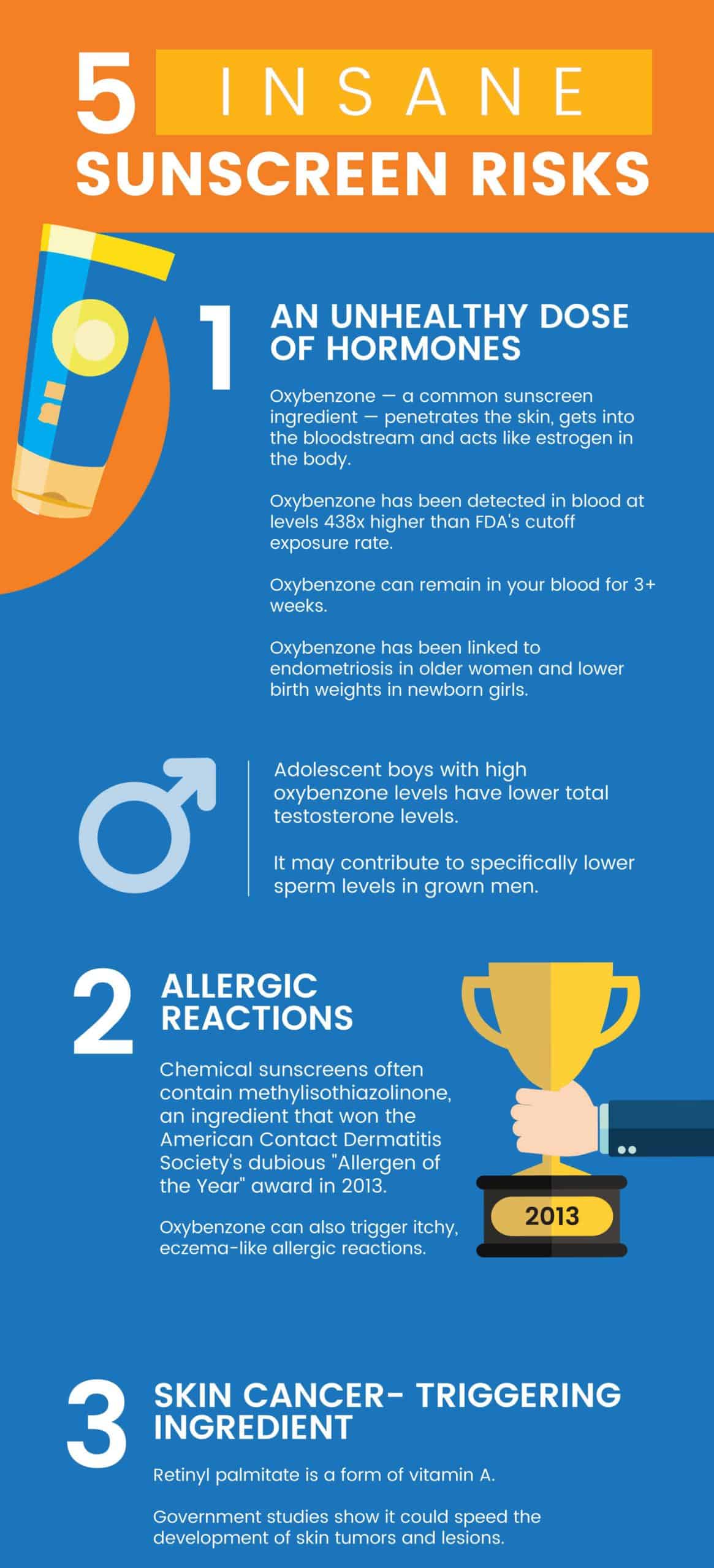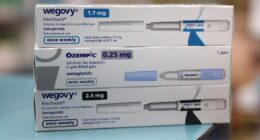
It’s no secret that the sun (in moderate doses) provides all sorts of health benefits, including helping our bodies manufacture vital vitamin D. With warmer weather right around the corner, though, many people are looking for the best sunscreens to cut their risk of sun overexposure, sunburns and possibly skin cancer
Environmental Working Group’s 16th annual Guide to Sunscreens is a mix of good and bad news when it comes to the state of sunscreens sold in American and beyond. For instance, oxybenzone — a suspected hormone-disrupting chemical that is readily absorbed into the body — is now present in 30 percent of the 1,850 products EWG investigated. While that may seem high, consider this: three years ago, about 60 percent of sunscreens contained this concerning chemical.
The National Toxicology Program released findings linking oxybenzone exposure to a higher risk of thyroid tumors in female rats. Even the European Commission, which reviews ingredient safety in Europe, published a final opinion finding oxybenzone unsafe for use at current levels.
“We slather these ingredients on our skin, but many of these chemicals haven’t been adequately tested,” says Carla Burns, EWG senior director for cosmetic science. “Despite the known toxicity concerns, oxybenzone is still widely used as a non-mineral active ingredient in sunscreens. The long-term use of these chemicals, and especially chemicals not adequately tested for safety, could be problematic.”
Sunscreen Chemicals Build Up in Your Blood
The effects of sunscreen may linger longer than expected, too. An FDA-led 2020 study found that “chemical sunscreen ingredients are systemically absorbed after one application, and some ingredients can stay in the blood for at least three weeks.”
The sunscreen chemicals tested include avobenzone, oxybenzone, octocrylene, homosalate, octisalate and octinoxate, and all six active ingredients tested readily absorbed into the bloodstream of humans in the study — and at concentrations that surpass an important FDA safety threshold.
This builds on previous research showing that sunscreen chemicals hit the bloodstream within a day of using them — and at levels high enough to prompt a government investigation on safety.
“We slather these ingredients on our skin, but these chemicals haven’t been adequately tested,” Leiba says. “This is just one example of the backward nature of product regulation in the U.S.”
Beyond safety issues is another question: Does sunscreen even work? Environmental Working Group’s found that nearly 75 percent of sunscreens don’t work and/or contain concerning ingredients that are readily absorbed by the body.
Things may be slowing moving in the right direction, but for now, the onus is still on the consumer to find sunscreen that’s safer and actually works.
Related: What Are Parabens? The Truth About This Common Cosmetic Ingredient
Are You Using the Best Sunscreens?
A past EWG report cited research of Brian Diffey, PhD, emeritus professor of photobiology at the Institute of Cellular Medicine at Newcastle University. He’s shown that, on average, U.S. sunscreens allow about three times more UVA rays to transfer through skin compared to European sunscreens. In fact, Americans sunscreen choices are fewer and often offer worse UVA protection compared to those available in the European Union.
This matters because UVA rays are more abundant than UVB rays, and UVA damage is more subtle than the sunburns induced mainly by UVB rays. UVA rays can damage your skin invisibly by suppressing the immune system and aging the skin over time; overexposure of these rays are also linked to the development of melanoma, squamous cell carcinoma and basal cell carcinoma, too.
According to EWG, most sunscreens sold in the U.S. would not be sold in Europe, which sets much more stringent UVA standards.
In the U.S., sunscreen regulations haven’t been updated since 2011. And while the FDA signaled it would take on the issue of UVA exposure, its recent proposal was withdrawn in the first coronavirus relief bill. The agency is due to propose its long-awaited rules on sunscreens again this fall.
Sunscreen Is Only One Tool in the Sun Safety Toolbox
Now, it’s important to note that there is no perfect sunscreen. Many contain harmful chemicals, and even mineral-based ones often contain nanoparticles, minute ingredients that can cross the blood-brain barrier and also harm aquatic life. Beyond that, sunscreen is unique compared to many other personal care products because you coat it thickly onto your skin, often multiple times a day. You don’t get that type of hours-long, skin-absorbing exposure with something like, say, shampoo you quickly wash off.
That’s why it’s very important to look for safer sunscreens if you use them and to recognize that you can’t only rely on sunscreens alone to prevent sun overexposure.
No product is going to be fully protective and no product will last on your skin for more than two hours max, EWG has noted in the past. They recommend thickly applying sunscreen coatings, reapplying every time you’re out of the water and choosing a better product to begin with are all key. But other sun smart methods to avoid overexposures are a must. In fact, sunscreen should actually be your last line of defense against the sun after adopting other more effective measures. More on those later.
READ RELATED: Homemade Makeup Remover
In the EWG’s 2022 best sunscreens report, the group analyzed the ingredients and labeling claims of more than 1,800 products with SPF. “The sunscreen industry continues to bury its head in the sand,” says Scott Faber, EWG’s senior Vice President for government affairs. “The market is flooded with products that provide poor UVA protection and use concerning ingredients. Sunscreen sales have increased dramatically, so sunscreen companies can certainly afford to conduct the studies needed to ensure their customers are safe.”
So what are the best sunscreens out there? Let’s take a look.
“Based on the best current science and toxicology data, we continue to recommend sunscreens with the mineral active ingredients zinc oxide and titanium dioxide, because they are the only two ingredients the FDA recognized as safe or effective in their proposed draft rules,” Burns says.
Here are some of the most highly rated sunscreens that met EWG’s criteria for safety and effectiveness:
- 365 Everyday Value Mineral Sunscreen Sport Lotion, SPF 30
- 3rd Rock Sunblock Sunscreen Lotion, Aromatherapeutic, SPF 35
- ATTITUDE Mineral Sunscreen, Fragrance Free, SPF 30
- All Good Sunstick, Unscented, SPF 30
- All Good Sunscreen Butter, 50+
- Badger Active Mineral Sunscreen Cream, SPF 30
- Badger Sport Mineral Sunscreen Cream, SPF 40
- Block Island Organics Natural Mineral Sunscreen Lotion, SPF 30
- Butterbean Organics Original Healthy Sunscreen Lotion, SPF 30
- C’est Moi GENTLE Mineral Sunscreen Lotion, SPF 30
- Earth Mama Tinted Mineral Sunscreen Lotion, SPF 25 & 40
- Eco Logical Skin Care All Natural Face Sunscreen Lotion, SPF 30+
- Eleven By Venus Williams On-The-Defense Sunscreen Lotion, SPF 30
- Erbaviva Organic Skincare Sunscreen Lotion, SPF 30
- Erin’s Faces Mineral Sunscreen Lotion, Body, SPF 32
- Green Goo Plants With Purpose Solar Goo Zinc Oxide + Shea Butter + Coconut Oil Sunscreen Cream, SPF 30
- Just Skin Food Natural & Organic Sunscreen Stick, SPF 30
- Kabana Organic Skincare Green Screen Sunscreen Lotion, Original, SPF 32
- Ke Ko Organics Ko’a Sun Cream, Tinted, SPF 31
- Laguna Herbals Face & Body Sunscreen Stick, Coconut, SPF 30
- Love Sun Body Mineral Sunscreen Lotion, Fragrance-Free, SPF 30 & 50
- Loving Naturals Clear Body Sunscreen Lotion, SPF 30+
- Maui Natural Organics All Natural Sunscreen Lotion, SPF 30
- Nurture My Body Pure and Simple Organic Sunscreen Lotion, SPF 32
- Nuori Mineral Defence Sunscreen Lotion, SPF 30
- Olita Kids Mineral Sunscreen Sunstick, SPF 30
- Pacific Beach Organics Riptide Sunscreen Lotion, Tinted, SPF 32
- Rocket Pure Natural Sunscreen Lotion, SPF 30
- Raw Elements Face + Body Sunscreen Lotion, SPF 30
- Sea Kind Alive Reef Safe Sunscreen, SPF 30
- Star Naturals Natural Sunscreen Stick, SPF 25
- Summer Lotion Natural Sunscreen Lotion, SPF 30
- SunBioLogic Men’s Sunscreen Lotion, SPF 30+
- Suntegrity Natural Mineral Sunscreen Lotion, Sport, SPF 30
- Suntribe Mineral Sunscreen Lotion, SPF 30
- Sunumbra Family Natural Sunscreen Lotion, SPF 30+
- thinksport Body & Face Sunscreen Stick, SPF 30
- thinksport Kids Body & Face Sunscreen Lotion, Sport, SPF 30
- Waxhead Sun Defense Sunscreen Stick, SPF 30
- Waxhead Sun Defense Skin Nourishing Sunscreen Lotion, SPF 30
Also of note, many sunscreen powerhouse brands are now offering safer options, although not all of these brands’ offerings are considered safer EWG picks. (Scores of 0-2 are considered safer, while higher scores indicate poorer safety ratings.) EWG has been analyzing and pushing for safer sunscreens for more than a decade, and positive shifts are occurring even within big brands and store brands. For instance, the following products made EWG’s best sunscreen list with a score of “2:”
- Banana Boat Kids Sport Sunscreen Stick, SPF 50+
- Coppertone Water Babies Pure & Simple Sunscreen Stick, SPF 50
- Coppertone Defend & Care Face Sunscreen Lotion, Oil Free, SPF 30
- Equate Kids Mineral Based Sunscreen Stick, SPF 5
- Neutrogena Sheer Zinc Mineral Sunscreen Lotion, SPF 30
- Neutrogena Clear Body Breakout Free Oil-Free Sunscreen Lotion, SPF 30
- Trader Joe’s Zinc Oxide Sunscreen Lotion, SPF 40
Related: Propanediol for Skin: Dangerous Additive or Multipurpose Solvent?
For its 2022 sunscreen report, EWG rated these products to be among the best:
- Algenist Alive Prebiotic Balancing Moisturizer, SPF 15
- AKT Therapy Elemental Sun Balm, SPF 30
- Andalou Naturals Men Face Guard Daily Mineral Sunscreen Lotion, SPF 30
- Ao Skincare 6000X Elemental Screen, SPF 30
- ATTITUDE Mineral Sensitive Skin Sunscreen, Fragrance Free, SPF 30
- Beautycounter Countersun Daily Sheer Defense for Face, SPF 25
- Biossance Squalane + Mineral, SPF 45
- Biossance Squalane + Zinc Sheer Mineral Sunscreen, SPF 30
- Block Island Organics Natural Face Moisturizer, SPF 30
- Cyberderm Every Morning Sun Whip, SPF 30
- Earth Mama Lady Face Mineral Sunscreen Tinted Face Stick, Light/Medium & Medium/Dark Tints, SPF 40
- Eleven By Venus Williams Unrivaled Sun Serum, SPF 35
- Juice Beauty Oil-Free Moisturizer, SPF 30
- Kari Gran Essential SPF Sunscreen Lotion, SPF 28
- Keys KPRO Tinted Moisturizer with Sunscreen, SPF 30+
- Love Sun Body Moisturizing Mineral Face Sunscreen Lotion, SPF 30
- Loving Naturals Daily UV Cream, Unscented, SPF 20
- MDSolarSciences Mineral Tinted Creme, SPF 30
- Marie Veronique Everyday Coverage Tinted Sunscreen Lotion, Extra Light Tint, SPF 30
- Raw Elements Daily Moisturizer, SPF 30
- Solara Suncare Clean Freak Nutrient Boosted Daily Sunscreen, Unscented, SPF 30
- Solara Suncare Time Traveler Ageless Daily Face Sunscreen, Unscented, SPF 30
- Suntegrity 5 in 1 Natural Moisturizing Tinted Face Sunscreen, SPF 30
- Sunumbra Daily Natural Sunscreen Lotion, SPF 15+
- thinksport Everyday Face Mineral Sunscreen Lotion, Naturally Tinted, SPF 30+
- White & Elm Everyday, SPF 15
While the products above rated “1” (remember, 0-2 are considered safest and most effective by EWG — the lower the score, the better), it is important to note that large beauty companies are creating safer options, too. For instance, EWG analysts scored Olay’s following three products scored “2.”
- Olay Regenerist Mineral Sunscreen Hydrating Moisturizer, Fragrance Free, SPF 15 & 30
- Olay Total Effects Whip Face Moisturizer with Sunscreen, Fragrance-Free, SPF 25
And if you’re looking for lip balm with SPF protection, EWG suggests these picks.
Top Picks for the Best Baby Sunscreens (and Overall Kid-Friendly Picks)
- 3rd Rock Sunblock Sunscreen Lotion, Infant, SPF 35
- Adorable Baby Sunscreen Stick, SPF 30+
- Badger Baby Active Sunscreen Cream, Chamomile & Calendula, SPF 30 & 40
- California Baby Everyday/Year-Round Sunscreen Stick, SPF 30+
- California Baby Super Sensitive Sunscreen Stick, SPF 30+
- Earth Mama Baby Baby Face Mineral Sunscreen Face Stick, SPF 40
- Earth Mama Baby Mineral Sunscreen Lotion, SPF 40
- Erbaviva Organic Skincare Baby Sun Stick, Lavender Chamomile, SPF 30
- Erbaviva Organic Skincare Baby Sunscreen Lotion, SPF 30
- Just Skin Food Baby Beach Bum Sunscreen Stick, SPF 31
- Nurture My Body Baby Organic Sunscreen Lotion, SPF 32
- Raw Elements Baby + Kids Sunscreen Lotion Tin, SPF 30
- Raw Elements Baby + Kids Sunscreen Stick, SPF 30
- Star Naturals Baby Natural Sunscreen Stick, SPF 25
- TruBaby Water & Play Mineral Sunscreen Lotion, SPF 30+
- UV Natural Baby Sunscreen Lotion, SPF 30+
- Waxhead Sun Defense Baby Zinc Oxide Vitamin E + D Enriched Sunscreen Lotion, SPF 35
- MADE OF Sunscreen Lotion, SPF 30
- thinkbaby Body & Face Sunscreen Stick, SPF 30
Most Toxic Sunscreens to Avoid
Here’s a big takeaway that’ll make things somewhat less complicated. EWG recommends avoiding all spray sunscreens. Not only are they very difficult to apply effectiveness and evenly, but there’s some concern the ingredients could potentially cause irreversible lung damage. The truth is, the ingredients just haven’t been tested in the aerosol capacity for long-term impact on human health, like so many other everyday chemicals, unfortunately.
When it comes to sunscreens, here are some of the other worst overall offenders scoring in the Red Zone (10) for major safety concerns. Overall, these products tested poorly in the EWG analysis and are considered bad choices for sun protection. Just remember, this list is not exhaustive. To check your favorite sunscreen or to peruse the database, click here.)
- Walgreens Dry Touch Sunscreen Lotion, SPF 100
- Panama Jack Sunscreen Continuous Spray, SPF 100
- Neutrogena Ultra Sheer Dry-Touch Sunscreen Lotion, SPF 85+
- Neutrogena Ultra Sheer Dry-Touch Sunscreen Lotion, SPF 100+
- Neutrogena Ultra Sheer Body Mist Sunscreen Spray, SPF 100+
- Neutrogena Sensitive Skin Mineral Sunscreen Lotion, SPF 60+
- Neutrogena Age Shield Face Oil-Free Sunscreen Lotion, SPF 110
- Equate Beauty Ultra Light Sunscreen Lotion, SPF 100
- CVS Health Ultra Sheer Lotion, SPF 100
- CVS Health Sensitive Skin Sun Lotion, SPF 60+
- CVS Health Ultra Protection Sun Lotion, SPF 100
- Coppertone Sport Sunscreen Lotion, SPF 100
- COOLA Classic Body Sunscreen Spray, Peach Blossom, SPF 70
- Banana Boat Ultra Sport Sunscreen Lotion, SPF 100
- Banana Boat Ultra Defense Clear Sunscreen Spray, SPF 100
- Banana Boat Kids MAX Clear Sunscreen Spray, SPF 100
- Australian Gold Botanical Natural Sunscreen Spray, SPF 70
This is by no means a complete list. Be sure to check your individual product’s safety assessment at EWG.org.


Key Findings in EWG’s Sunscreen Report
- About 40 percent of sunscreens in EWG’s 2022 Guide to Sunscreens contain oxybenzone, an ingredient linked to thyroid cancer in female rates; it’s a suspected hormone disruptor.
- Your skin is your body’s largest immune system organ. Excess sun exposure can impair the immune system, but many sunscreen chemicals are readily absorbed into the bloodstream, where they could cause ill effects, too.
- Stanford University dermatologists concluded that people who relied solely on sunscreens for sun protection got more sunburns than people who reported infrequent sunscreen use but wore hats and clothing to shield themselves from the sun.
- An EWG analyst warns: “Sunscreen is only one form of sun protection and should not be relied on alone. It’s also important to wear sunglasses, hats and t-shirts, stay in the shade, and avoid the midday sun.”
- The rate of new melanoma cases amongst American adults has tripled since the 1970s.
- Evidence is increasing that UVA exposure causes skin cancer. Despite that, sunscreen rules requiring adequate UVA protection are lacking.
- FDA proposed to strengthen UVA requirements for U.S. sunscreen, but the improvements were put on hold as part of the legislation passed within a coronavirus stimulus bill.
- About 75 percent of sunscreen products reviewed by EWG either didn’t work adequately to protect from UV rays and/or they contained dangerous ingredients. Some of the most worrisome ingredients include oxybenzone, one of the known endocrine disruptors, and retinyl palmitate, a form of vitamin A that may harm skin and possibly lead to skin tumors.
- Oxybenzone is in widespread use in American chemical-based sunscreens. Lab testing shows skin penetration rates of 1 to 9 percent. That’s concerning, given the fact that it acts like an estrogen in the body and is linked to abnormal sperm function in animal studies and endometriosis in studies of women. Oxybenzone also acts as a skin allergen in a significant number of people. (So does methylisothiazolinone, a common sunscreen preservative found in the majority of products surveyed.) Thankfully, places like Hawaii and Key West have banned oxybenzone in sunscreen due to its ability to bleach and kill coral reefs.
- In a previous EWG review, about 40 percent of sunscreens contained vitamin A ingredients. This type of ingredient can react with UV rays and increase the risk of skin tumors, according to government animal testing data.
- Scientists don’t know for sure if sunscreen helps prevent melanoma. In fact, as EWG notes in its executive summary of the sunscreen guide, “Sun exposure appears to play a role in melanoma, but it is a complex disease for which many questions have not been answered. One puzzling fact: Melanomas do not usually appear on parts of the body that get daily sun exposure.”
- Be wary of ultra high SPF claims. There are more of them today than several years ago. The U.S. hasn’t approved modern sunscreen ingredients that would do a better job of broad-spectrum protection. Because of this, UVA protection is often lacking in SPF 70+ products. In other developed countries, SPF is usually capped at 50.
- Avoid spray sunscreens. It’s very difficult to apply in a thickness that will provide adequate protection, plus, it increases the risk you’re sending potentially damaging sunscreen chemicals directly into your lungs (and the lungs of everyone sitting around you.)
- Nearly 25 percent of sunscreens tested in 2022 were sprays.The FDA is proposing that all sprays and powders undergo additional proposes that all spray products undergo additional safety testing to ensure they can’t be inhaled deep into the lungs and cause irreversible damage.
- Inactive ingredients often make up 50 to 70 percent of sunscreen formulations, and EWG urges the FEA to investigate the safety of these ingredients, too.
- FDA pilot testing uncovered spray sunscreen products that would not meet proposed standards.
- EWG recommends that consumers avoid all spray and powder sunscreen products.
- If you’re opting for sunscreen for protection from overexposure to the sun, EWG advises to opt for mineral-based sunscreen products with zinc oxide or titanium dioxide active ingredients and avoid products with ingredients like oxybenzone and retinyl palmitate.
- If you avoid the sun, get your vitamin D levels checked at your healthcare provider. A growing number of the population is deficient, thanks to sunscreens and spending more time indoors.
The good news is you can get enough vitamin D and protect yourself from burns without always turning to sunscreen.
How to Avoid Too Much Sun
Getting some sun exposure is vital for good health because it helps your body create vitamin D. There are multiple ways to get vitamin D, but your best bet is to get it from standing in the sun or eating vitamin D-rich foods. In fact, sitting in the sun unexposed for about 10 minutes helps your body create roughly 10,000 units of natural vitamin D.
Vitamin D deficiency has been linked to certain cancers, autoimmune diseases, heart disease depression, osteoporosis and many other ailments, so it’s important to get enough. Like almost anything, though, you can get too much of a good thing and want to make sure you avoid sunburns.
You should consider sunscreen your last resort to prevent sunburns, though. In fact, there’s no clear evidence that using sunscreens actually prevents skin cancer — including in the best sunscreens — and some ingredients may actually fuel skin cancer.
Avoiding overexposure during peak sunlight hours, use sunglasses, and sun-protective hats and clothing (Solumbra is a good brand). These things reduce your risk of burns without sunscreen.
Final Thoughts
- When direct sunlight hits our skin under peak conditions, our bodies manufacture high levels of vitamin D. Not getting enough vitamin D has been linked to all sorts of health problems, including cancer, arthritis, depression and other diseases.
- However, you can get too much of a good thing, which is why it’s important to take steps to prevent overexposure and sunburns.
- There is no perfect sunscreen. Mineral sunscreens generally rate safer, but they often contain nanoparticles that are not tightly regulated or studied for long-term impact on human or aquatic health. Chemical sunscreens often contain hormone-disrupting chemicals or even an ingredient that could trigger skin cancer. Still, EWG’s report helps consumers seeking sunscreen find safer choices while avoiding the most poorly rated brands.
- Sunscreen should be used as a last resort. Sun-protective measures like hats, sunglasses, seeking shade and avoiding peak sunlight for extended periods of time should be used before turning to sunscreen, and when you do choose sunscreen, make sure it’s one of the best sunscreens.
Source: Dr. Axe






